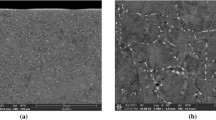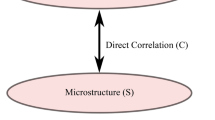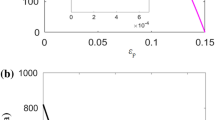Summary
A micromechanical method was developed for predicting the precipitation hardening response of particle strengthened alloys hardened by ordered precipitates based on the microstructure, composition, and heat treatment, and utilizing a minimum number of experimental tests to evaluate the microstructural constants of the overall model. The overall approach was based on incorporating the dislocation particle interaction mechanics, particle growth and coarsening theory, thermodynamics, and particle strengthening mechanisms applicable to precipitation hardened alloys as part of the overall micromechanical method. The method/model evaluates, from a minimum number of experimental tensile tests, microstructural constants necessary in determining the precipitation srengthening response of a particle strengthened alloy. The materials that were used as vehicles to demonstrate and evaluate the model were precipitation hardenable aluminium-lithium-zirconium and nickel-aluminum alloys. Utilizing these demonstration alloys, the method used a total of four tensile tests to evaluate the necessary microstructural constants and thus predict the variation in strength as a function of aging time, aging temperature, and composition, for the underaged, the peak-aged, and the overaged conditions. Predictions of the precipitation strengthening response were made incorporating the Wagner particle distribution model to evaluate the size distributions of particles in the microstructures. The predicted variation of strength with aging practice and composition using the Wagner distribution model compared well with the corresponding experimental yield strength results.
Similar content being viewed by others
Abbreviations
- b :
-
Burgers vector
- \(\bar d\) :
-
average particle size diameter for a particle distribution
- d loop :
-
particle looping diameter for dislocation bypassing by Orowan looping
- f v :
-
volume fraction of precipitates
- h(ϱ):
-
Wagner particle size distribution function
- n total :
-
total number of precipitate particles per unit area on a given microstructural plane
- \(\bar r\) :
-
average particle size radius for a particle distribution
- \(\bar r_{pl} \) :
-
average planar particle size radius on a given microstructural plane
- t :
-
aging time, in hours
- \(\bar A_{pl} \) :
-
average planar particle cross sectional area
- G t :
-
total shear modulus of the material
- K c :
-
particle growth rate constant
- \(\bar M\) :
-
texture or Taylor grain orientation factor
- N v :
-
total number of precipitate particles per unit volume
- Q A :
-
activation energy for diffusion
- R :
-
universal gas constant
- T :
-
aging temperature
- λ:
-
the interparticle separation or spacing
- σ y :
-
yield strength
- σ q :
-
as-quenched strength
- Δσ i :
-
intrinsic lattice strength
- τ c :
-
critical resolved shear strength
- Δ τ loop :
-
critical resolved shear strength for dislocation particle bypassing via. Orowan looping
- Δ τ particle :
-
total critical resolved shear strength for particle strengthening
- Δ τ shear :
-
critical resolved shear strength for dislocation particle shearing, in underaged state
References
Wagner, C.: Theories associated with age hardening and overaging during Ostwald Ripening. Zeitschrift für Elektrochemie37, 581–591 (1961).
Lifshitz, I. M., Slyozov, V. V.: The kinetics of precipitation from supersaturated solid solutions. J. Phys. Chem. Solids19, 35–50 (1961).
Ardell, A. J., Nicholson, R. B.: The Coarsening of γ in Ni−Al Alloys. J. Phys. Chem. Solids27, 1793–1804 (1966).
Glazer, J., Morris, J. W.: The Effect of the Precipitate Size Distribution on the Aging Curve of Order Hardened Alloys. Acta Metall.36, 907–915 (1988).
Annual Book of ASTM Standards, “Metals Test Methods and Analytical Procedures”, Vol. 3.01, Am. Soc. Test. Mater. Philadelphia, PA, Section 3, 1988.
McKeighan, P. C.: Summary of Tensile Testing Al-2.6wt.%Li-0.09wt.%Zr Alloy, Purdue NSF-sponsored ERC Project Program Inception, pp. 1–159, 1991.
Phillips, V.: A Metallographic Study of Precipitation in a Ni-12.7at.%Al Alloy. Acta Metall.14, 1553–1547 (1966).
Phillips, V.: Hardening Mechanisms in a Precipitation Hardenable Nickel-12.71 at.% Aluminum Alloy. Philos. Mag.16, 103–117 (1967).
Shercliff, H. R., Ashby, M. F.: A Process Model for Age Hardening of Aluminum Alloys: The Model. Acta Metall.38 (10), 1789–1802 (1990).
Melander, A., Persson, P. A.: Strength of δ′ Hardened Nickel-Base Alloy. Metal Sci. 391–398 (1978).
Zedalis, M. S., Fine, M.E.: Precipitation and Ostwald Ripening in Dilute Al Base Zr-V Alloys. Metall. Trans.17, 2187–2198 (1986).
Ardell, A. J.: The Growth of γ′ Precipitates in Aged Ni−Ti Alloys. Metall. Trans.1, 525–534 (1970).
Sauthoff, G., Kahlweit, M.: Precipitation in Ni−Si Alloys. Acta Metall.17, 1501–1509 (1969).
Chellman, D. J., Ardell, A. J.: The Coarsening of δ′ Precipitates at Large Volume Fractions. Acta Metall.22, 577–588 (1974).
Orowan, E.: Symposium on Internal Stresses in Metals and Alloys, Session III Discussion, Institute of Metals, London England, p. 451, (1948).
Martin, J. W.: Micromechanisms in Particle-Hardened Alloys, pp. 1–94, New York: Cambridge University Press 1980.
Ardell, A. J.: Precipitation Hardening. Metall. Trans.A (16), 2131–2165 (1985).
Underwood, E. E.: The Effect of a Dispersed Second Phase on the Recrystallization of Aluminum-Copper Alloys. Journal Institute of Metals92, 124–125 (1964).
Underwood, E. E.: Quantitative Sterology. Addison-Wesley 1970.
Ashby, M. F., Ebeling, R.: On the Determination of the Number, Size, Spacing, and Volume Fraction of Spherical Second-Phase Particles from Extraction Replicas. Trans. Metall. Soc. AIME236, 1396–1404 (1966).
Corti, C. W., Cotterill, P., Fitzpatrick, G. A.: The Evaluation of the Interparticle Spacing in Dispersion Alloys. Int. Metall. Rev.19, 77–88 (1974).
Hilliard, J. E.: The Counting and Sizing of Particles in Transmission Microscopy. Trans. Metall. Soc. AIME224, 906–917 (1962).
Bansal, P. P., Ardell, A. J.: Average Nearest Neighbor Distances Between Uniformly Distributed Finite Particles. Metallography5, 97–111 (1972).
Shercliff, H. R., Ashby, M. F.: Modelling of the Response of Heat- Treatable Aluminum Alloys to Thermal Processing, Final Report. Cambridge University Engineering Department, CUED/C-Mat./TR156, 1989.
Munjal, V., Ardell, A. J.: Precipitation Hardening of Ni-12.19at%Al Alloy Single Crystals. Acta Metall.23, 513–520 (1975).
Glazer, J., Morris, J. W.: Strengthening Contributions of Strong Ordered Precipitates. Philos. Mag. A56, 507–515 (1987).
Huang, J. C. C.: Microstructural Evolution and Strengthening Mechanisms in Two Ternary Aluminum-Lithium-Copper Alloys. Ph.D. Diss. University of California, Los Angeles, 1986.
Moreau, C., Allouche, A., Knystautas, E. J.: Measurements of the Diffusion Rate of Lithium in Aluminum at Low Temperature by Elastic Recoil Detection Analysis. Appl. Phys.58 (12), 4582–4586 (1985).
Wen, J. C., Weppner, W., Boukamp, B. A., Huggins, R. A.: Electrochemical Investigation of Solubility and chemical diffusion of Lithium in Aluminum. Metall. Trans. B.11B, 131–137 (1980).
Costas, L. P.: U.S. Atomic Energy Commission Report, VASEC Rep. DP-813, 1963.
Mahalingam, K.: Precipitation Behavior of δ′ in Binary Aluminum-Lithium Alloys. Ph.D. Diss. Purdue University of Material Science Engineering 1989.
Glazer, J.: A Theoretical Analysis of the Aging Response of Ordered Alloys. Masters Thesis, Lawerence Berkeley Laboratory, University of California, Berkeley, California, 1986.
Noble, B., Harris, S. J., Dinsdale, K.: Yield characteristics of Aluminum-Lithium Alloys. Metal. Sci.16, 425–430 (1982).
Jensrud, O.: Hardening Mechanisms and Ductility of an Al-3.0wt.%Li Alloy. In: Proceedings of the Third International Aluminum-Lithium Conference, Oxford, Aluminum-Lithium Alloys III, (Baker, C., Gregson, P. J., Harrison, S. J., Peel, C. J., eds.), pp. 411–419, London: The Institute of Metals 1985.
Taylor, G. J.: Plastic Strain in Metals. Metals62, 307–325 (1938).
Glitz, R., Notis, M., Goldstein, J. I.: AEM Study of Early Stage Growth of the Ni3Al Intermediate Phase in NiAl−Ni Diffusion Couples. In: Proceedings of an International Conference on Solid-solid Phase Transformations, (Aaronson, I., Laughlin, D. E., Sekerka, F., Wayman, C. M., eds.), pp. 691–695. The Metallurgical Society of AIME 1981.
Haasen, P.: Plastic deformation of Nickel single crystals at low temperatures. Philos. Mag.3, 384–418 (1958).
Davies, R. G., Stoloff, N. S.: On the Yield Stress of Aged Ni−Al Alloys. Trans. Metall. Soc. AIME223, 714–719 (1965).
Hornbogen, E., Roth, M.: The Distribution of Coherent Particles in Nickel Alloys. Zeitschrift für Metallkunde58, 842–855 (1967).
Maheshwari, A., Ardell, A. J.: Anomalous Coarsening Behavior of Small Volume Fractions of Ni3Al Precipitates in Binary Ni−Al Alloys. Acta Metall. et Mater.40 (10), 2661–2667 (1992).
Hirata, T., Kirkwood, D. H.: The Prediction and Measurement of Precipitate Number Densities in a Nickel-6.05wt.% Aluminum Alloy. Acta Metall.25, 1425–1434 (1977).
Ardell, A. J., Munjal, V., Chellman, D. J.: Precipitation Hardening of Ni−Al Alloys Containg Large Volume Fractions of γ. Metall. Trans.7a, 1263–1268 (1976).
Tsumuraya, K., Miyata, Y.: Coarsening Models Incorporating Both Diffusion Geometry and Volume Fraction of Particles. Acta Metall.31 (3), 437–452 (1983).
Ardell, A. J.: Observations on the Effect of Volume Fraction on the Coarsening of γ′ Precipitates in Binary Ni−Al Alloys. Scr. Metall. et Mater.24, 343–346 (1990).
Ardell, A. J., Nicholson, R. B.: On the Modulated Stracture of Aged Ni−Al Alloys. Acta Metall14, 1295–1309 (1966).
Swalin, R. A., Martin, A.: Solute Diffusion in Nickel-Base Substitutional solid Solutions. J. Metals, Transactions of AIME206, 567–572 (1956).
Author information
Authors and Affiliations
Rights and permissions
About this article
Cite this article
Fragomeni, J.M., Hillberry, B.M. A micromechanical method for predicting the precipitation hardening response of particle strengthened alloys hardened by ordered precipitates. Acta Mechanica 138, 185–210 (1999). https://doi.org/10.1007/BF01291844
Received:
Revised:
Issue Date:
DOI: https://doi.org/10.1007/BF01291844




